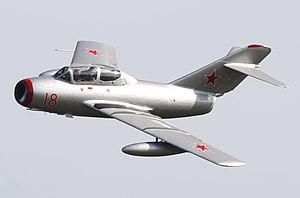
Back MiG-15 Afrikaans Mikoyan-Gurevich MiG-15 AN ميكويان جوريفيتش ميج-15 Arabic MiQ-15 Azerbaijani МиГ-15 Bulgarian Mikoian-Gurévitx MiG-15 Catalan MiG-15 Czech Mikojan-Gurevitj MiG-15 Danish Mikojan-Gurewitsch MiG-15 German Mikoyan-Gurevich MiG-15 Greek
| MiG-15 | |
|---|---|
 A Soviet Air Forces MiG-15UTI two-seater trainer over Duxford Air Festival 2017 | |
| General information | |
| Type | Fighter aircraft |
| National origin | Soviet Union |
| Manufacturer | Mikoyan-Gurevich |
| Status | In limited service with the Korean People's Army Air Force |
| Primary users | Soviet Air Forces (historical) |
| Number built | 13,130 in the USSR + at least 4,180 under license |
| History | |
| Introduction date | 1949 |
| First flight | 30 December 1947 |
| Developed into | Mikoyan-Gurevich MiG-17 |
The Mikoyan-Gurevich MiG-15 (Russian: Микоян-Гуревич МиГ-15; USAF/DoD designation: Type 14; NATO reporting name: Fagot) is a jet fighter aircraft developed by Mikoyan-Gurevich for the Soviet Union. The MiG-15 was one of the first successful jet fighters to incorporate swept wings to achieve high transonic speeds. In aerial combat during the Korean War, it outclassed straight-winged jet day fighters, which were largely relegated to ground-attack roles. In response to the MiG-15's appearance and in order to counter it, the United States Air Force rushed the North American F-86 Sabre to Korea.[1]
When refined into the more advanced MiG-17, the basic design would again surprise the West when it proved effective against supersonic fighters such as the Republic F-105 Thunderchief and McDonnell Douglas F-4 Phantom II in the Vietnam War of the 1960s.
The MiG-15 is believed to have been one of the most produced jet aircraft with more than 13,000 manufactured.[2] The MiG-15 remains in service with the Korean People's Army Air Force as an advanced trainer.
- ^ Thompson, Warren. "Sabre: The F-86 in Korea." Flight Journal, December 2002. Retrieved: 30 June 2011.
- ^ "Mikoyan-Gurevich MiG-15 (Ji-2) Fagot B.", Smithsonian National Air and Space Museum, archived from the original on 20 December 2015